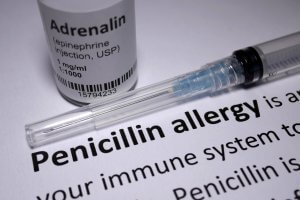Penicillin is an antibiotic that is used to treat many types of bacterial infections. Penicillin belongs to a family of over 15 chemically related drugs, such as amoxicillin, and is one of the most frequently prescribed classes of antibiotics in the world. Approximately 10% of patients in the U.S. report a history of penicillin allergy. Among hospitalized patients, 20% report a history of penicillin allergy. However, over 90% of people who report this allergy are not really penicillin allergic. According to The American College of Allergy, Asthma & Immunology, the following are the main reasons that patients are mistakenly labeled as having a penicillin allergy:
- Penicillin allergy diminishes or resolves after several years have passed in many patients.
- Penicillin allergy was initially misdiagnosed because of the reaction, which is usually a rash, was due to the viral or bacterial infection the patient acquired, not the drug.
- Another medication taken at the same time may have caused the reaction.
- Often, an adverse reaction, such as diarrhea or upset stomach, was mistakenly labeled as an allergic reaction.
Because 90% of patients diagnosed with penicillin allergy are avoiding all penicillin-related drugs, they are treated with alternative broad-spectrum antibiotics, which have a higher risk of significant side effects. This results in increased antibiotic resistance, higher medication and medical costs, and increased hospitalization stays.
If you have a history of penicillin allergy, make an appointment with one of our allergists. After a careful review of your allergy history, when deemed appropriate, we can administer highly sensitive skin testing to screen for penicillin allergy. Penicillin skin testing, followed by an oral challenge, is the most reliable method for evaluating true penicillin allergy.